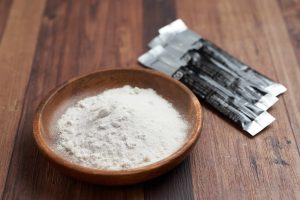A burnt tongue is a common problem that can result from eating or drinking something too hot, exposure to factors such as chemical burns, or smoking.
While most symptoms of a burnt tongue can be relieved with at-home remedies such as rinsing the affected area, topical treatments, or cool drinks, some cases may require medical care.
iprogressman / Getty Images
1. Rinse With an Oral Saline Solution
- Create a saline solution of one-eighth teaspoon of salt with a cup of warm water.
- Rinse your mouth gently.
- Spit out the solution.
The natural antiseptic qualities of salt can reduce pain, swelling, and other burn symptoms.
The use of warm water provides an additional benefit by improving tissue survival at the site of the burn, which can limit damage after the burn injury.
2. Run a Stream of Cool Tap Water Over Your Tongue
Run a stream of cool water over your tongue in 20-minute increments for up to three hours.
The cool water will help soothe the pain, reduce the spread of heat, and limit burn depth. It also helps to accelerate the formation of new skin over a wound, which is the first step in wound healing.
3. Suck on Popsicles or Ice Chips
Sucking on ice pops, such as Popsicles, or ice chips can help relieve pain and prevent blisters in tongue burns.
Avoid chewing ice cubes since this can damage your teeth. The cold temperature can also help reduce swelling and inflammation caused by the burn on the surface of your tongue.
4. Take an Over-the-Counter Pain Reliever
An over-the-counter (OTC) pain medication such as Tylenol (acetaminophen) or Advil and Motrin (ibuprofen) can help relieve pain and reduce the inflammation that occurs with a burnt tongue.
5. Use Vitamin E on the Burn
Vitamin E can promote the healing process necessary to restore your tongue to normal. To do so, squeeze the contents of a 1,000 international units (IU) liquid vitamin E capsule directly onto your tongue.
Research indicates that the direct application of vitamin E to a burn wound can improve wound outcomes.
6. Apply Honey as a Tongue Coating
Honey can be used to accelerate wound healing in tongue burns. In treating superficial and partial-thickness tongue burns, honey treatment can effectively control infection much better than the results you can achieve with other standard treatments. It can also absorb harmful, unstable molecules called free radicals, which interfere with the healing process.
7. Cover Your Tongue With Milk
Cow’s milk is a rich source of calcium, which can play a major role in accelerating wound healing and improving wound quality after healing.
Research indicates that milk can be beneficial in preparing damaged tissue and promoting wound activity in severities up to full-thickness burns.
8. Treat Your Tongue With a Topical Anesthetic
Topical anesthetics such as Anbesol and Orajel contain benzocaine, an anesthetic that numbs the affected area to relieve minor pain and irritation from minor burns.
Follow package directions and do not use it more often than directed. Wash your hands before using this gel to avoid introducing germs to the affected area and after application to avoid spreading benzocaine to your eyes and other parts of your body.
What to Avoid With a Burnt Tongue
- Alcohol-based mouth rinses
- Carbonated beverages
- Citrus fruits and juices
- Hard, coarse foods
- Hot foods and beverages
- Ointments, butter, or toothpaste
- Spicy foods
- Tobacco and tobacco products
How Long Does It Take for a Burnt Tongue to Heal?
The amount of time it takes for a burnt tongue to heal on its own depends on the severity of your burn, as follows:
- Mild, superficial first-degree burns: These involve just the outermost layer of your tongue. This type of burn will heal on its own within about a week.
- Severe burns: These need more time to heal, they should be healed within about two weeks, which is also the amount of time it takes to regenerate taste buds damaged by a burn.
Your tongue heals quickly because the mucous tissues in your tongue contain many blood vessels, which helps increase blood flow and oxygen to the affected area, promoting healing. In addition, research indicates that your saliva contains a protein that may promote healing.
When to See a Provider
Minor, first-degree burns usually heal on their own without medical treatment. Symptoms of a first-degree burn include:
- Pain that lasts 48 to 72 hours then subsides
- Peeling skin
- Redness
- Swelling
However, a first-degree burn that is very large, present in an older adult or an infant, or seems more extreme than normal should receive immediate medical care.
You should also see a healthcare provider for a burned tongue if you suspect a second- or third-degree burn that involves the following symptoms:
- Blistering
- Difficulty breathing, eating, or moving your tongue
- Intense pain, swelling, or redness that worsens
- Involving both the outer and underlying layers of skin on the tongue
- Charred or blacked tongue
- Dry or leathery texture to the skin on your tongue
- Involving all layers of the skin on your tongue, including the deep layers
- Numbness or intense pain
- White tongue
A tongue burn with any of the following symptoms also requires immediate medical care:
- Burning of the second layer of skin
- Fever not relieved by medication
- Red streaks radiating from the burn
- Severe damage or pus coming out of your tongue
- Swollen lymph nodes
A Word From Verywell
A burnt tongue may seem alarming at first, but, thankfully, it is usually self-limiting (heals on its own), heals quite readily, and there are ways to reduce the discomfort while it is healing.
:max_bytes(150000):strip_icc()/Khoo-Edmund-web-002_ppR2-9b06b31a8f4c490a8f1c990abfeb4c2b.jpg)
Summary
A burnt tongue usually occurs as a result of eating or drinking something too hot. It can also occur from hot vapors, and corrosive or flammable objects. When treated promptly, most minor tongue burns heal in about a week with simple home treatment. This can involve applying topical remedies and avoiding foods that can irritate the burn and postpone healing.
Contact your healthcare provider for treatment of deeper tongue burns. A burnt tongue that does not improve within a week of home treatments or shows signs of infection should also be treated by a healthcare provider.
-
Cleveland Clinic Health Essentials. 7 remedies to heal a burnt tongue.
-
Colgate. 4 tips to soothe a burnt tongue.
-
Tobalem M, Harder Y, Tschanz E, et al. First-aid with warm water delays burn progression and increases skin survival. J Plast Reconstr Aesthet Surg. 2013;66(2):260-266. doi:10.1016/j.bjps.2012.09.014
-
Rousselle P, Braye F, Dayan G. Re-epithelialization of adult skin wounds: Cellular mechanisms and therapeutic strategies, Advanced Drug Delivery Reviews, 2019;146;344-345. doi:10.1016/j.addr.2018.06.019
-
American Academy of Dermatology Association (AAD). How to treat a first-degree , minor burn.
-
Thompson MA, Zuniga K, Sousse L, et al. The role of vitamin E in thermal burn injuries, infection, and sepsis: a review. J Burn Care Res. 2022;43(6):1260-1270. doi:10.1093/jbcr/irac100
-
Subrahmanyam M. Topical application of honey for burn wound treatment – an overview. Ann Burns Fire Disasters. 2007;20(3):137-139.
-
Hemmati, AA, Larki-Harchegani A, Shabib S, et al. Wound healing property of milk in full thickness wound model of rabbit, International Journal of Surgery, 2018;54 (Part A):133-140. doi:10.1016/j.ijsu.2018.04.030
-
Cleveland Clinic. Benzocaine dental or oral gel, paste, or solution.
-
Wiktor A, Richards D. Treatment of minor thermal burns. Moreira ME, Torrey SB, Ganetsky M, eds. UpToDate. UpToDate; 2022.
-
University of Pennsylvania: OncoLink. Mucositis (mouth sores) & oral care tip sheet.
-
Cleveland Clinic. Burned tongue.
-
Prasetyaningtyas N, Jatiatmaja NA, Radithia D, et al. The response of the tongue epithelial on cigarette smoke exposure as a risk factor for oral cancer development. Eur J Dent. 2021;15(2):320-324. doi:10.1055/s-0040-1721312
-
Children’s Hospital of Philadelphia. First-degree burns.
-
Brand HS, Ligtenberg AJ, Veerman EC. Saliva and wound healing. Monogr Oral Sci. 2014;24:52-60. doi:10.1159/000358784
-
MedlinePlus. Burns.
:max_bytes(150000):strip_icc()/IMG_09172-9ca0040fa5e74df0b5aac42d8125d477.jpeg)
By Anna Giorgi
Giorgi is a freelance writer with more than 25 years of experience writing health and wellness-related content.
Thanks for your feedback!
What is your feedback?








